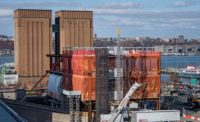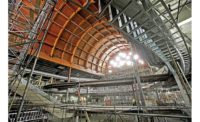Transforming a former four-story freight terminal in lower Manhattan that once serviced elevated trains into a 12-floor, 1.3-million-sq-ft hub for Google was bound to require an innovative design and construction program to deliver a workplace fit for a tech industry leader.
When the project team faced a tight schedule to open the new facility, it developed a pioneering solution borrowed from bridgebuilding that could encourage greater use of precast concrete for building cores in New York City.
Google will lease and occupy the St. John’s Terminal building at 550 Washington St., which spans two city blocks between Spring and Houston streets in lower Manhattan. It encompasses the southern portion of the former terminus for the old freight line, whose former elevated tracks have become the iconic High Line walkway and park on the West Side.
Railroad tracks are among various preserved and restored features of the classic terminal, which is being developed by Oxford Properties Group with Turner Construction as construction manager and COOKFOX Architects as lead design firm.
A project spokesman did not respond to a request to confirm the cost of the Google transformation, but in earlier media reports it was estimated at more than $1 billion.
New Construction Playbook
The task has required ensuring the existing structure could support loads from expanding to 12 stories of steel frame and cast-in-place concrete floors. That, along with two new high-rise elevator cores and the goal to open in 2022, meant the project team had to look beyond the traditional construction playbook, says Jim White, vice president on Oxford’s construction team.
Members, which include structural engineer Entuitive, core contractor Rizzani de Eccher (RDE), steel and core erector Metropolitan Walters, and panel manufacturer Jersey Precast, collaborated on a novel solution—a building core of precast concrete panels with matching Lego-style connections instead of a costlier, more time-consuming cast-in-place option. “We had a creative team that pulled together in a positive way,” White says.
The matching technique brings time savings and greater precision in fabrication and erection, he says. “We’re pressing the limits of precast to a higher level of tolerances,” White adds.
While using precast concrete sounds logical to achieve time savings, there was no suitable precedent in high-rise construction in New York, says Riccardo Castracani, an executive at RDE, which is actually a bridge contractor.
“Here we basically built a bridge span but instead of horizontal it is vertical,” he says.
The team employed “match casting, the technology that we use in bridges where one precast element is cast against a previous precast element,” Castracani says. “In that way, any casting problems or mistakes can be corrected with the next segment. So we never carry errors along with us. We always continuously correct, and that is how we keep everything within millimetric tolerances.”
Solution Emerges
The innovation in the match-casting process could greatly benefit the project and similar construction efforts, but it would need proprietary or patentable software to become a distinct product or investable concept, says Michael Spies, partner at Navitas Capital, a venture capital firm that invests in real estate and construction technology.
“What’s unique and significant about this is how it’s an efficiency gain,” he says. “If they create a more efficient workflow solution that can work for other projects and don’t have to repeat the brain damage to get there, they’ve created something that has value.”
The core design came together last summer when no one knew it would be well-suited for the coronavirus pandemic, which brought construction to a standstill and restricted jobsite activity. For the terminal, disruptions ended up being minimal, and the project remains on schedule, White says.
One reason is that Jersey Precast was able to enact safe workplace protocols to keep panel fabrication on track, he explains. Also, to erect the precast panels, the onsite crew is only one-quarter of the size of a cast-in-place team, making it easier to create safe worker distances, says Robert Hubner, Turner’s project executive.
“If we had to have those 40- to 50-person crews in a tight confined space, we would have had a lot of constraints, and potentially big delays,” he says. “It was an unforeseen benefit.”
Demo and Design
The old freight terminal posed several challenges, starting with complicated demolition tasks, says Brian Jaffee, Oxford director of construction. That work, which began in early 2019, included detaching the structure from a span over Houston Street, which the team demolished to free up a northern tract for another development. The team also removed a fifth floor added by a previous tenant, he says. The “surgical” demolition, along with temporary bracing, created greater lateral stability throughout the entire building, allowing work to proceed on a faster track, White says.
Demolition had begun when the team started discussions about accelerating the timeline, Jaffee says. “We made the change to the precast core somewhere around the summer of 2019,” he says.
Oxford assembled much of the same team that helped it build a 16-span segmented precast deck over railyards in Manhattan’s Hudson Yards development several years ago. The task at St. John’s was to build two separate 14-story precast cores, each of which will house fire stairs and 14 elevator shafts from the sub-level to the upper roof bulkhead.
“So we used that idea,” says Barry Charnish, principal at Entuitive. “It’s really a vertical stacking of the segmented precast approach, with post-tensioning, both vertically and horizontally. This is connected to a starter system in the basement, which is conventional cast-in-place concrete.”
Strong and Stable
The precast also serves to stabilize the original long and squat structure, which lacked “an identifiable lateral system” and was not “built that accurately,” Charnish says. “We’re also framing it to steel, which required us to be very mindful of the various tolerances. Precast gives us certain advantages in reducing the concern about tolerances.”
That need for precision also applies to the core system’s interface with post-tensioning rods and couplers, structural steel link beams, floor steel and insert plates with deformed bar anchors, he says.
Those exacting requirements underscore the core system’s complexity, says Amir Ulislam, principal at Jersey Precast. “Building something like this, which is being post-tensioned in two different directions and match cast in two different directions, also in two different planes, is really unique,” he says. “A typical bridge segment job is matching to something in one plane or one direction. This is a whole added degree of difficulty.”
The design also allows the system to carry the required loads, Ulislam says. “This job has about 380 pounds of steel per cubic yard of concrete,” he says. “In general, for structural concrete, the rule of thumb is about 150 to 200 pounds per cubic yard.”
It helped to have Entuitive’s lead project design engineers, David Stevenson and Tanya Luthi, on site both at the terminal and in the fabrication facility, Ulislam says. “These guys are really there with over-the-shoulder inspection and over-the-shoulder problem-solving for conflicts,” he adds. “They would issue changes and guidance on any problem we came up with literally in hours—minutes sometimes.”
Time and Cost Saver
The precast core created significant time savings, shortening the construction schedule by two months thanks to many factors, Jaffee says. By stabilizing the building, the team won’t need to add a whole new bracing system to support upper-floor steel erection and decks, Charnish says. Interlocking precast elements also entail far less onsite welding and bolting than cast-in-place cores, and end panel finishes preempt need for drywall to cover installed pieces, he says.
The system also streamlined the design and construction process, Jaffee says. The team rapidly moved into shop drawings in the third quarter last year and created the panel mold at the end of 2019.
The first panels were fabricated early this year, with core panel erection starting just as the COVID-19 pandemic swept into New York City, Jaffee says. The team was able to get back on track in late spring when local authorities eased restrictions on construction sites, he says.
Perhaps the biggest time savings is from a simple advantage: With precast panels, the team can use its steel erector, Metropolitan Walters, to assemble the core, Jaffee says.
“That’s where a lot of schedule savings come from, to have the core and steel erected simultaneously by the same erector,” he says. That means fewer trades on site, greater work sequencing efficiency and, notably, fewer tower cranes, says Dave Pisacrita, Metropolitan Walters principal.
Using one trade “to furnish, install and erect a precast system with a steel system, the initial savings is in cranage,” he says. “We only have two cranes on this entire structure. For a building of this size, it could easily handle four to five cranes if there was a subcontractor doing the core. That alone is several million dollars worth of savings for the project.”
Simple Advantage
A single erector also simplifies work to install 220 precast panel segments, each 50 tons, which total 4,200 cu yd of concrete, 1.1 million lb of reinforcing steel and 500,000 lb of structural steel embedments. With multiple crews, that could be a logistics nightmare, but one erector can avoid the lag of waiting for cast-in-place core formwork and scaffolding to get several floors ahead before steelwork can begin on a particular floor, switching back and forth from steelwork to precast as needed, Hubner says. “It gives us a lot of flexibility,” he says.
A controlled precast installation process is also safer than a cast-in-place core effort involving form and rebar, Hubner says. And the core installation cycle for each floor occurs much faster than with cast-in-place pours, Pisacrita adds.
The team also is using precast for stairs, elevator lobbies and infill slabs, which will save time and boost safety, allowing crews on steelwork and decks to avoid temporary ladders, Jaffee says. As the core system rises, it makes ongoing selective demolition safer by stabilizing the structure, White says.
The project team has been trucking panels from New Jersey to Manhattan and assembling the core since late spring and is set to continue the work into the fall, Hubner says. It will start erecting the concrete on metal deck, top out the building and install the exterior in late December. Interior work starts in 2021, with substantial completion in spring 2022, he says.
Another satisfying element of the precast core is the team’s use of a polyurethane-poured mold to create a form liner—an architectural finish that gives the panels a wood planking texture, White says.
While it became a challenging extra feature for the precast fabricator, it allows the panels to serve as finished walls on the interior, avoiding the addition of drywall, he says.
That flourish fulfills the design team’s vision “to maintain the authenticity of the building and its original history as an industrial building,” White says. “Rather than hiding it, the core has become somewhat of a showpiece.”












Post a comment to this article
Report Abusive Comment